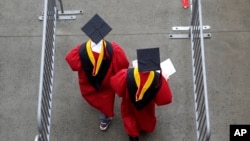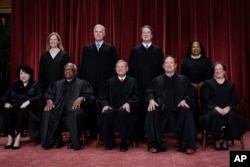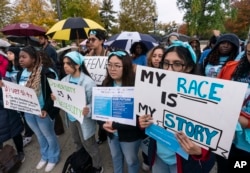In 1961, President John F. Kennedy issued an executive order that called on government contractors to "take affirmative action” to ensure that applicants and employees be treated “without regard to their race, creed, color, or national origin."
“It was really a recognition that African Americans were excluded from the American dream for many years,” says Natasha Warikoo, author of “Is Affirmative Action Fair? The Myth of Equity in College Admissions.” “Meanwhile, selective colleges also wanted to increase representation, particularly of African Americans, because there were very few African Americans in these elite colleges. And so, they had their own kind of programs to bring in more African American students … and then taking into account race in the admissions process grew, as well.”
Today, affirmative action refers to policies designed to increase representation of minorities and women at work and in higher education. The purpose of affirmative action in higher education is two-fold, says Katharine Meyer, a fellow at the Brookings Institution.
“One is to increase the diversity of the student body, the rationale there being that exposure to diverse viewpoints and diverse perspectives is going to enrich the experience of all students,” Meyer says.
The second purpose is more reparative, to reach out to students who might not have equal access to a high-quality high school education or quality advice on how to navigate the college admissions process.
“Part of affirmative action is to identify students who would have thrived had they been placed in a ZIP code, say, that had the higher quality teachers, higher quality counselors, higher quality academic experiences, and to admit them to the institution where they believe they will thrive when they have access to those resources,” Meyer says.
Sixty years later, affirmative action remains controversial in the United States and has faced earlier court challenges. Right now, the U.S. Supreme Court is considering two cases that argue that affirmative action discriminates against Asian American students. As a result, the justices could ban admissions policy that uses race as a factor.
“It really violates all of our ideals,” says Mike Gonzalez, a senior fellow at the Heritage Foundation who supports ending affirmative action. “We're a multiethnic country where it's very important that government, or even the private sector, do not use race to pick and choose who rises and who doesn't rise. And getting into a school is one of the most important rungs in the ladder of success.”
Nine states — California, Washington, Florida, Michigan, Nebraska, Arizona, New Hampshire, Oklahoma and Idaho — have outlawed affirmative action based on race. Some colleges in those states now use other criteria — like admitting students in the top 10% of their high school's graduating class — in an effort to ensure diversity.
“In places where they have banned affirmative action … we've seen drops with the racial representation relative to the high school population, when the school stopped engaging in affirmative action,” Meyer says.
A 2013 study found that, following an affirmative action ban in some states, there was a 23% drop in the likelihood of admission for students of color at those states’ public colleges.
“We should never be OK with injustice. We should never be OK with disparities that persist. We should be constantly trying to address them. So, that’s not OK,” Gonzales says. “We should have an urge, as a society, to see what we can do to improve America and make sure that everybody has the opportunity to succeed.”
Warikoo, who is also a sociology professor at Tufts University in Massachusetts, says there is no way to select the very best students, because not everyone agrees on what qualities and qualifications a “best” student should have.
“We should get away from this idea of what's fair and what's not fair and think much more about what is our goal here as university?” she says. “Do we want to have a higher education system that is accessible to people regardless of their class backgrounds or their racial background?... Are we trying to create diverse leadership for tomorrow? These are the kinds of things that I think colleges should be thinking much more about. What is our mission, and how do we select students to best further that mission?”
Gonzales says there are certain qualities that don’t include race or ethnicity that colleges should look for in a student.
“Activities, what you contribute to charity, how well-rounded a person you are, how much leadership you demonstrate. All of these things have to do with merit and good citizenship. None of those things have to do with the immutable characteristic of what your race is or your category,” Gonzales says. “Race or category or national background is an awful way to make any choice by government or by the private sector. It should be so obvious to everybody that I don't even understand why I have to explain this.”
Warikoo worries about the potential long-term impacts of the Supreme Court striking down race-based admissions.
“I don't want to be dramatic, but I think it undermines our democracy,” Warikoo says. “[Americans] are very much invested in this idea of education as a pathway to social mobility, to success, to a good life. But if we have a kind of elite education system in which students are selected that don't look like a cross-section of 18-year-olds in the United States, then that's problematic.”
The Supreme Court is expected to rule on the future of race-based admissions by June.




